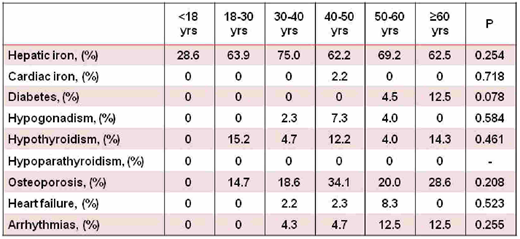Abstract
Background: Non-transfusion-dependent thalassemia (NTDT) is a term used to indicate patients who do not require lifelong regular transfusions for survival. Morbidity in NTDT patients is more common and serious than previously recognized. This study aimed to examine the association of age with the presence of iron overload assessed by Magnetic Resonance Imaging (MRI) and cardiovascular and endocrine complications in NTDT patients.
Methods: We considered 170 patients with thalassemia intermedia never transfused o who received occasional transfusions consecutively enrolled in the Myocardial Iron Overload in Thalassemia (MIOT) project. Iron overload was quantified by the T2* Magnetic Resonance Imaging (MRI) technique. All complications were classified according to international guidelines.
Results: Six groups of patients were identified: age<18 years (N=7), age 18-30 years (N=36), age 30-40 years (N=48), age 40-50 (N=45), age 50-60 years (N=26), and age≥60 years (N=8). The Table shows the comparison among the groups.
The youngest patient showing hepatic iron (MRI liver iron concentration-LIC>3 mg/g dw) had 9 years of age and the frequency of hepatic iron did not significantly increase with age.
Only one patient showed cardiac iron (global heart T2*<20 ms).
Diabetes appeared only in patients with more than 50 years and showed a trend toward increasing with increasing age. Hypothyroidism and osteoporosis were not present in pediatric patients and were not associated to age. Hypogonadism was not present in patients with less than 30 years and its frequency was comparable among the age groups. No patient showed hypoparathyroidism.
Only patients older than 30 years showed a cardiac complication (heart failure or arrhythmias), but the rate did not significantly increase with increasing age.
Conclusions: Our data in NTDT are indicative of high rate of liver iron overload at early age and extremely rare cardiac iron overload. Endocrine or cardiac complications were not present in pediatric patients but in adult patients the frequency did not increase with advancing age.
Pepe:Chiesi Farmaceutici S.p.A., ApoPharma Inc., and Bayer: Other: No profit support.
Author notes
Asterisk with author names denotes non-ASH members.


This feature is available to Subscribers Only
Sign In or Create an Account Close Modal